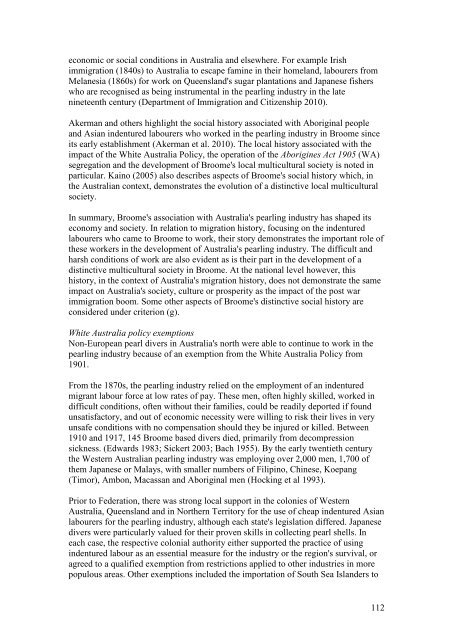WEST KIMBERLEY PLACE REPORT - Department of Sustainability ...
WEST KIMBERLEY PLACE REPORT - Department of Sustainability ...
WEST KIMBERLEY PLACE REPORT - Department of Sustainability ...
Create successful ePaper yourself
Turn your PDF publications into a flip-book with our unique Google optimized e-Paper software.
economic or social conditions in Australia and elsewhere. For example Irish<br />
immigration (1840s) to Australia to escape famine in their homeland, labourers from<br />
Melanesia (1860s) for work on Queensland's sugar plantations and Japanese fishers<br />
who are recognised as being instrumental in the pearling industry in the late<br />
nineteenth century (<strong>Department</strong> <strong>of</strong> Immigration and Citizenship 2010).<br />
Akerman and others highlight the social history associated with Aboriginal people<br />
and Asian indentured labourers who worked in the pearling industry in Broome since<br />
its early establishment (Akerman et al. 2010). The local history associated with the<br />
impact <strong>of</strong> the White Australia Policy, the operation <strong>of</strong> the Aborigines Act 1905 (WA)<br />
segregation and the development <strong>of</strong> Broome's local multicultural society is noted in<br />
particular. Kaino (2005) also describes aspects <strong>of</strong> Broome's social history which, in<br />
the Australian context, demonstrates the evolution <strong>of</strong> a distinctive local multicultural<br />
society.<br />
In summary, Broome's association with Australia's pearling industry has shaped its<br />
economy and society. In relation to migration history, focusing on the indentured<br />
labourers who came to Broome to work, their story demonstrates the important role <strong>of</strong><br />
these workers in the development <strong>of</strong> Australia's pearling industry. The difficult and<br />
harsh conditions <strong>of</strong> work are also evident as is their part in the development <strong>of</strong> a<br />
distinctive multicultural society in Broome. At the national level however, this<br />
history, in the context <strong>of</strong> Australia's migration history, does not demonstrate the same<br />
impact on Australia's society, culture or prosperity as the impact <strong>of</strong> the post war<br />
immigration boom. Some other aspects <strong>of</strong> Broome's distinctive social history are<br />
considered under criterion (g).<br />
White Australia policy exemptions<br />
Non-European pearl divers in Australia's north were able to continue to work in the<br />
pearling industry because <strong>of</strong> an exemption from the White Australia Policy from<br />
1901.<br />
From the 1870s, the pearling industry relied on the employment <strong>of</strong> an indentured<br />
migrant labour force at low rates <strong>of</strong> pay. These men, <strong>of</strong>ten highly skilled, worked in<br />
difficult conditions, <strong>of</strong>ten without their families, could be readily deported if found<br />
unsatisfactory, and out <strong>of</strong> economic necessity were willing to risk their lives in very<br />
unsafe conditions with no compensation should they be injured or killed. Between<br />
1910 and 1917, 145 Broome based divers died, primarily from decompression<br />
sickness. (Edwards 1983; Sickert 2003; Bach 1955). By the early twentieth century<br />
the Western Australian pearling industry was employing over 2,000 men, 1,700 <strong>of</strong><br />
them Japanese or Malays, with smaller numbers <strong>of</strong> Filipino, Chinese, Koepang<br />
(Timor), Ambon, Macassan and Aboriginal men (Hocking et al 1993).<br />
Prior to Federation, there was strong local support in the colonies <strong>of</strong> Western<br />
Australia, Queensland and in Northern Territory for the use <strong>of</strong> cheap indentured Asian<br />
labourers for the pearling industry, although each state's legislation differed. Japanese<br />
divers were particularly valued for their proven skills in collecting pearl shells. In<br />
each case, the respective colonial authority either supported the practice <strong>of</strong> using<br />
indentured labour as an essential measure for the industry or the region's survival, or<br />
agreed to a qualified exemption from restrictions applied to other industries in more<br />
populous areas. Other exemptions included the importation <strong>of</strong> South Sea Islanders to<br />
112
















